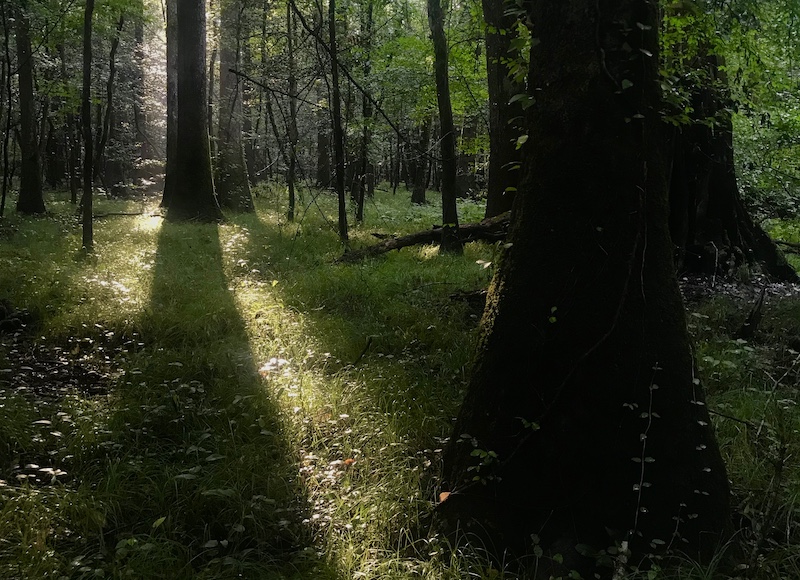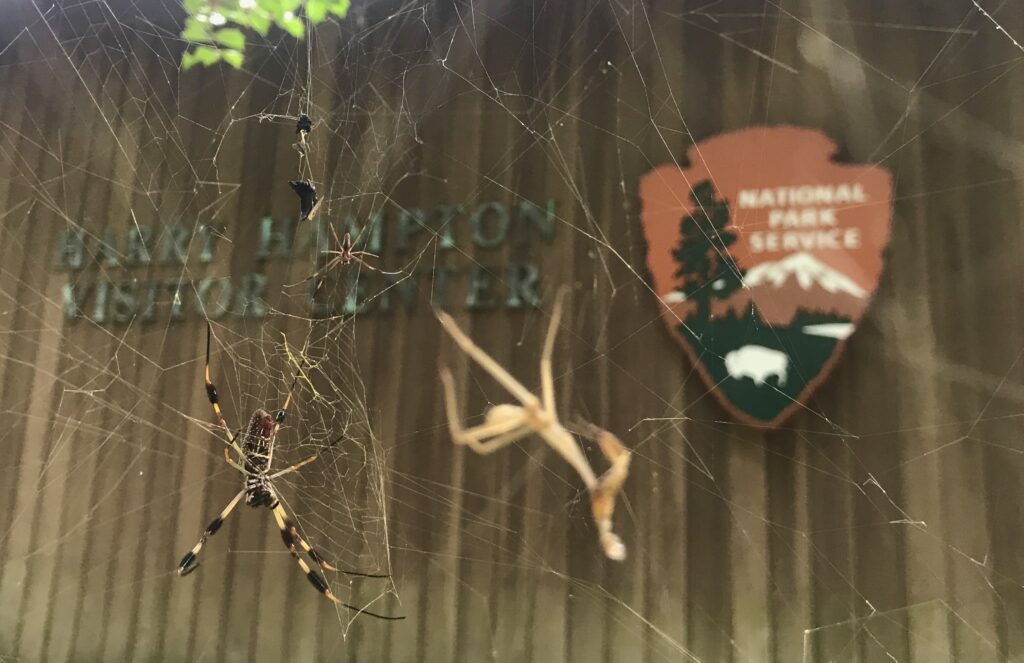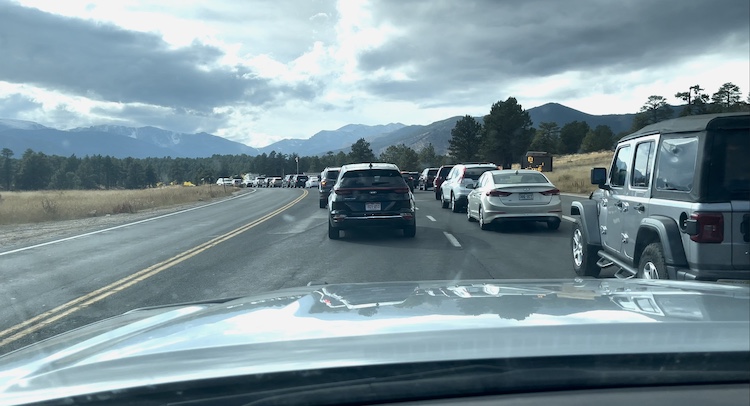Congaree National Park
South Carolina’s Congaree National Park is not a crowded park. Its gates are open wide, free of polluted lanes backed up of traffic. Its parking lots offer a wide array of empty spots, assuring that your shiny metal coffin is unlikely to sustain a scratch from a careless minivan that parks too close.
And from my experience, there is no shortage of campsites available to an adventure bound traveler who cruises into the park in an unplanned fit of spontaneous South Carolina wanderlust.

This is a swamp after all, albeit a very pretty swamp, as far as swamps go. Its groves of banyan trees comprise the largest old-growth forest east of the Mississippi River, and its loblolly pines are the tallest trees in South Carolina. Its streams often lie as still & silent as the dead of night, yet somehow glow clear and glassy.
This park definitely has mood… But still, not many travelers dream of a relaxing vacation in a swamp.
I have 3 trips to Congaree under my belt, and have camped in the park each of these times, the last being in the summer of 2019. I pulled into the park, grabbed a campsite at the Longleaf Campground, paid my fee at a dropbox, and headed into the park to hike a quick boardwalk loop that runs out through the park’s massive banyan trees to Weston Lake.
I don’t recall specifically, but I don’t remember anyone else being in the campground on this visit, although someone may have been at another distant campsite. It was so uncrowded however, that I really didn’t even notice.
Nevertheless, NPS officials at Congaree have found it necessary to resort to a reservation system in order for visitors to secure a campsite at both the Longleaf Campground, and the more remote Bluff Campground, which doesn’t even provide vehicle access. Yep, walk-in camping only at Bluff my friends… But you’ll need a reservation for campsites way out there, and the fee is going up.
Congaree Raising Campground Fees
In a press release dated December 1, 2022, Congaree announced that the fees for these quiet campgrounds will be increasing. As of January 1, 2023, the walk-in sites at Bluff are doubling, from the current $5 per night to $10. The rates at Longleaf, where I have always stayed, without neighbors mind you, are raising from $10 to $15, and the group site will move to $25 from $20. Why you may ask?…

In what appears to be a rare lapse of hush-lippedness surrounding the actual financial arrangement between the NPS and Rec.gov, the press release details that the NPS pays what are termed “contractor line item costs” (CLINs) to Rec.gov. These CLINs are fees that the park service pays its recently befriended corporate partner in order to absolve itself of the burdensome task of collecting the those pesky campground fees in the form of cash envelopes.
According to the release, these CLINs currently cost Congaree $6-8 per campground reservation, and are subtracted from the total camping fee. A quick examination of these numbers reveals that the park is actually losing money on the Bluff Campground reservations at the current rate. If Rec.gov charges $6-8 per reservation, and the park is charging $5 for a nightly reservation, we find a shortfall of $1-3 per transaction. Thus, the fees must be increased…
Does Congaree need a Reservation System?
This begs a few questions: Was the financial administration of a campground too laborious a task for the NPS to handle? Is this park just too busy to properly manage its overflowing campgrounds? Does Congaree actually need a reservation system?
These all seem unlikely scenarios.

The National Park Service has been providing campgrounds and collecting camping fees for nearly a century, and it would seem they should have a handle on this business model, perhaps even be turning a profit by now. The success of industry giant KOA clearly demonstrates that there is a hefty amount of money to be made with campgrounds, and they have to buy and pay taxes for the land upon which their campgrounds are situated, while the parks have no debt on their land, and further, pay no taxes.
A quick look at the visitation numbers from Congaree suggests that it is not “too busy” to deal with the financial administration of its campgrounds. In 2021, the park received 215,181 visitors. As national park visitation numbers go, this is not exactly a busy park, and we can assume that a small fraction of those would likely desire a campsite in a swamp. Again, I’ve camped there on three separate occasions over the past decade, and don’t recall seeing a soul.
Of course, given such nominal visitation statistics, we must run on the assumption that the park is not heavily staffed. In fact, given today’s staffing complications on a national scale, we can assume that they are likely understaffed. This is a common claim of the parks, which probably has a fair level of validity.
Nevertheless, we’re not looking at a complicated method here. Many campgrounds have found the means by which to remain viable for decades by simply providing a metal deposit tube that securely holds campground fees deposited by campers upon arrival at their chosen site, on a first-come, first-served basis.

Historically, many campgrounds with a decent amount of traffic place seasonal campground hosts on site, who stay in the their own RV. This is usually a volunteer position that costs the park nothing, aside from the power and water used by the volunteer host. Even at a quiet campgrounds such as those at Congaree, this seems financially viable.
So in review of these questions, it seems highly unlikely that this a park really in need of a such a seemingly Faustian service.
Rec.gov is Everywhere these Days
If a modern-day traveler visits many national parks, they are certainly bound to encounter the need to utilize the Rec.gov system. This company is everywhere now.
Wanna enter Rocky Mountain National Park during the summer season? How bout a trip into John Muir’s sacred Yosemite Valley? Glacier’s Going to the Sun Road? Or a morning trip up Acadia’s Cadillac Mountain? Well, you’ll need a reservation to do any of these activities… & if you’ve likely guessed where you’ll obtain that. Yep, Rec.gov.
“Oh, but Park Junkie, our parks are just too busy!” you say… “We need this reservation system to keep the numbers down!” you say… ” We are loving our precious parks to death!” you say…

Well, I’m going to argue that we’re loving our “parking lots” to death, but that’s a subject for another story (stay tuned). Nevertheless, let’s toss a few other examples on the table:
Out-of-the-way areas of unknown parks such as Lassen Volcanic National Park are now using Rec.gov to distribute reservations for backcountry camping access. What was just a year ago a simple kiosk form at the trailside, without a fee at all, is now a reservation only system ran through Rec.gov. I’ve had some fabulous hikes in Lassen, as late as 2019, & I didn’t see a soul in the backcountry, even in “popular” areas such as Devil’s Kitchen, and the Cinder Cone. Just so we’re clear, nothing in Lassen can be accurately described as “popular”.
How about the case of Voyageurs National Park in Minnesota? You been up there? I didn’t think so. Not many have… You wanna go canoe camping in this remote park’s scenic northern woods?
Well, don’t just cruise into the Ash Creek Visitor Center hoping to score a permit, as I did in in the summer of 2017. You’ll need a reservation, & you can already guess where you get that. Luckily, this visitor center does have an old computer & printer, where you can sign on to Rec.gov and obtain your permit. I returned in 2019 for another solo kayak trip out to Kettle Falls, but I was an old pro by then and had already made my deal with the devil to access my public land.
Areas such as Grand Canyon National Park’s remote Toroweap location, which lies at the end of a three-mile, high-clearance 4×4 trail, which lies at the end of a sixty-mile dirt road, that crosses the desolate reaches of the God-forsaken Arizona Strip, now requires a reservation to enter. Of course, that goes through Rec.gov.

Now, if you’re one of the unfortunate souls who makes their way out to the Toroweap gate without a reservation, you’ll be turned around by a friendly ranger at a quiet little remote ranger station, who will kindly inform you that you’ll need a permit. Oh, and he’ll also inform you that the nearest cellular service by which you can obtain that permit, is a sixty-mile drive back up the lonely dirt road you just came down.
Grand Canyon National Park, it turns out, has simply locked down the entire northern area of the park on the Arizona Strip. Remote sections of this 1.2 million acre national treasure, such as Kanab Point, Twin Point and Kelly Point, now require a permit to access.
These areas are far more remote than Toroweap, with single lane, miles-long 4×4 trails the only method of access. There is NO ONE out there. There are no masses of IG influencers or YouTubers falling off of ledges, climbing on hoodoos or swinging golf clubs out there… There is NO ONE out there. Period.
Yet you’ll now need to pay Rec.gov for the privilege of visiting these little-known scenic vistas, which are public land, by the way.
So why did Congaree move to the Reservation System?
Well, since you asked, I’ll give you my opinion. This is all fairly simple. Lobbyists from Rec.gov are continually pressuring upper-ranking officials from the Department of Interior and the National Park Service, as well as the Bureau of Land Management and the Department of Agriculture’s National Forest Service, to implement more reservation systems across the board, in order to “preserve the public land and to enhance the visitor experience“, of course.
Why else would this system be expanding at its current rate? It’s a corporate money grab, plain & simple.

To a leery observer, it may seem that the National Parks are quickly becoming the Rec.Gov Parks. This is a scary scenario my friends. It appears that what we are witnessing is the privatization of the entrance process to our most treasured lands. I believe Fredrick Law Olmsted, John Muir, Stephen Mather & Theodore Roosevelt, all hard-fought proponents of public land and unfettered public access to those lands, are rolling over in their graves with anger as you read these very words.
This was not easy to see in the early years of Rec.gov, a mere decade, or even five years ago. Unless you wandered around the parks endlessly, you likely never really had to deal with the task of paying a private corporation to access your land.
It was resentfully understandable that we may need to address overcrowding concerns in Rocky Mountain, or Yosemite Valley, so the Rec.gov system was sort of begrudgingly accepted.
Today however, the beast is out of the bag. These corporate barons have taken the reservation expansion too far, too fast. When the public sees areas that are in no need of regulations, such as those listed above, being swept into the realm of reservation requirements, head scratching ensues. For me, it became the simple journalistic pursuit of “follow the money”.
Who owns Rec.gov?
So I did. I asked myself, who is making money from this? Is it the park? Who owns this Rec.gov thing? A quick bit of research revealed that I’m not the only one curious about this, but unfortunately, there aren’t many out here making it known. A few have thankfully.
Just last week, a cat named Matt Stoller released a telling story on this public/private corporate lovefest over on his Substack account. His tale is telling, demonstrating that Booz Allen Hamilton is making an unfathomable amount of money through its recent partnership with the parks and public lands in America.
It should be pointed out that much of the park-going public seems to believe this money is going to the parks, as they’ve never been told differently…. It’s not.
As Stoller revealed in his November 29 piece, “Why is Booz Allen Renting Us Back Our Own National Parks?” the Booz is making more than $100,000 per lottery from hikers applying to acquire a permit with a 33% success rate on California’s Mount Whitney alone. Such lotteries are not limited to the tallest peak in the lower 48.
This monster controls access to more than 4,200 facilities and 113,000 actual sites sprinkled from the tropical Florida Everglades to the tundra of Alaska’s Denali National Park, and one begins to realize that these are not small earnings for the Booz. In fact, I recently learned that you can even use Rec.gov to cut down a Christmas Tree in Wyoming now. Santa will not give any “good” points for that one.
Now if you’re not familiar with the Booz, let’s just remind you of who they are. Cause it’s highly likely you’ve heard of them in the past, and if you haven’t heard of them, you’ve definitely heard of their most famous employee…
Wanna know who? Well, I need some way to keep you coming back… So we’ll hold off on that for a minute. I’ll be releasing a story on that in the coming week or so. I’m tired of all this drama at the moment however, so I’m going for a walk in the woods…
I’ll catch y’all on down the trail…. Cheers
Relevant Links
NPS – Congaree National Park – Campground Fee Increase Press Release
Park Junkie’s National Park Newscast
Park Junkie National Park Guides
